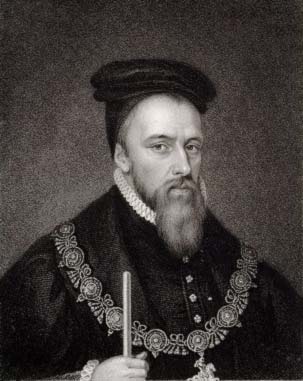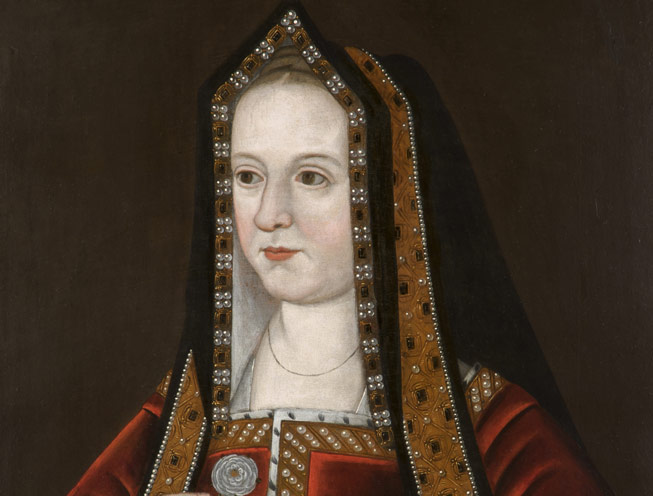
I love the Tudors. The marriages, the wars, the monarchs, the executions: who needs ‘East Enders’ when we have a real life soap opera to talk about? Just as I think there’s nothing new left to discover about this fascinating, if undeniably bloodthirsty, dynasty, someone provides a fresh take.
This time, it’s Dr Nicola Tallis, who has just published a biography of Margaret Beaufort, grandmother of Henry VIII and great-grandmother of Elizabeth I. This is the first complete biography of Beaufort to be published for 30 years, so please forgive this lengthy post, inspired by Dr Tallis’s brilliant talk at the British Library…
Margaret Beaufort was never a monarch – much as she might like to have been. However, she was “queen in all but name”. Henry VII’s mother was “devout and awe-inspiring”, but she also lived an “exceptionally colourful” life – and Dr Tallis’s book sets out to demonstrate how different the “archival” Margaret – i.e. the Margaret who Dr Tallis discovered during her research – is from the “traditional” Margaret. This is a woman who experienced tragic lows and unprecedented highs; one of the most influential characters of the 15th century.
Margaret Beaufort was born on 31 May 1443, the only child of John Beaufort, Duke of Somerset, and Margaret Beauchamp of Bletso. Tragically, John committed suicide when Margaret was just one year old, leaving his daughter a wealthy heiress – and a pawn of ambitious men.
Aged just 12, Margaret married Edmund Tudor, becoming Countess of Richmond – a title she retained for the rest of her life. Her marriage made her the sister-in-law of Henry VI – and a participant in the growing conflict in England.
Margaret and Edmund set up home in a luxurious palace in Pembrokeshire. Despite her youth, and despite the fact that many of their contemporaries believed 12 too young to be married (even if the Church decreed it legal) Edmund was adamant that Margaret should fulfil her “marital duties”. He wanted an heir.
By the summer of 1456, Margaret was pregnant – however, on 3rd November Edmund died, leaving his wife alone, vulnerable – and “consumed with fear” due to plague, and politics. Margaret turned to her brother-in-law, Jasper, for support. At Pembroke Castle, following a horrendous childbirth which left both physical and mental scars, Margaret gave birth to a son: Henry.

There existed an “extraordinary” bond between mother and son, which continued throughout both their lives. Henry would be Margaret’s only child: Dr Tallis believes this to have been a conscious choice on Margaret’s part.
Bearing in mind that Margaret was only 13 years old: on 3 January 1458 she took control of her own destiny by marrying Sir Henry Stafford. The couple took up residency in Lincolnshire and by all accounts theirs was a very happy marriage.
By now, the War of the Roses was well underway – and following the 1461 Battle of Mortimer’s Cross, Edward IV took the throne. Margaret was forced to ingratiate herself with her enemies – which she did, admirably. With Jasper having fled the country, Henry was made Edward’s ward, with Margaret allowed the occasional visit.
In 1468, Margaret and Henry moved to one of Margaret’s favourite homes, in Woking, where they lived a life of luxury, enjoying hunting and hawking and hosting visits from the king. However, just one year later Henry Tudor’s guardian was killed in battle in front of Henry. Filled with fear, Margaret eventually learned that Henry had escaped to safety with William Herbert.
In April and May of 1471, Edward IV won two decisive victories – and their ramifications had dire consequences for Margaret. On 21st May, Henry VI, the last of the Lancastrian figureheads, was murdered in the Tower of London. And on 4th October Margaret’s husband, badly injured in the Battle of Barnet, died.

Aware of how vulnerable her position was, with Jasper and her son in exile, Margaret remarried eight months later to Thomas Stanley, 1st Earl of Derby. That gentleman was often required to be at court, and Margaret frequently accompanied him.

(Reasonably) secure again, Margaret was busily trying to negotiate a reconciliation between the king and her son and had nearly achieved it – when Edward died. With Richard III now king, Edward’s two sons were sent to the Tower of London – never to be seen again. Was Margaret involved in their murder? Historians have never been able to agree.
What’s certain is that Margaret was determined to put her son on the throne. Henry, however, having spent most of his life in exile, was relatively unknown in England. Having begun conspiring with Elizabeth Woodville to marry Henry to Woodville’s daughter, Elizabeth of York, Margaret soon found herself in serious trouble. The Buckingham Rebellion went horribly wrong and, after Buckingham was executed, Margaret found herself charged with high treason.
She was lucky. Richard III could not risk alienating Stanley, so Margaret received a relatively lenient punishment: stripped all of her lands, she was placed in ‘house’ custody.
Undeterred, Margaret continued to plot. And her ambition paid off: in 1485, Henry invaded England and on 22 August he fought Richard III at the Battle of Bosworth. Miraculously – Henry’s army was heavily outnumbered – Richard was defeated and killed. Margaret’s son was now King Henry VII of England.

Margaret was heavily rewarded for her role in Henry’s triumph and made feme sole; a highly unusual honour which made her legally independent from her husband. She would later take a vow of chastity to reinforce that fact.
From this point on, Margaret took control of her own identity and I loved hearing about the ways in which this immensely wealthy woman chose to spend her money. We’re so used to the portraits of Margaret wearing black that we assume it’s due to her pious nature. Not so: wearing black was a symbol of wealth. As was gold – of which Margaret’s spectacles, and their cases, were fashioned. Margaret loved to be entertained and her household accounts detail considerable expenditure on dancing, singing and Margaret’s two fools. Margaret also enjoyed cards, chess and gambling.
In 1486, Henry finally married Elizabeth of York and their son, Arthur, was born later that year: the first Tudor heir. They named their second child after Margaret. Henry and Elizabeth would go on to have five more children, including the future Henry VIII, although only four of them survived infancy. Margaret was extremely proud of her grandchildren and took a keen interest in them.

During the first decade of Henry’s reign, Margaret was a constant presence at court, always at the forefront of court ceremonials. How Elizabeth felt about this is unknown, however there are no records of any disputes between the two women. Margaret, the uncrowned queen, was refusing to live in the shadows any longer.
Determined to be a force for good, Margaret paid off many of her peers’ debts, gave money to the homeless and founded Christ’s College, Cambridge and Lady Margaret College, Oxford: the first Oxford college to admit women.
Having moved to Collyweston, Margaret lived a life of “unprecedented luxury”. There, she employed 200 staff – even then, a huge number for one woman – who wore the blue and silver livery of the Beaufort family and adored their employer. Margaret was now an “unofficial lieutenant” of the north of England and the Midlands, a fact she acknowledged by adding a counting house and jail to Collyweston Palace. Never before had a woman been entrusted with such a role.
In 1501, Margaret swapped Collyweston for Coldharbour, in London. Prince Arthur was marrying Catherine of Aragon and Margaret hosted a number of entertainments for the couple, including a new play which she’d commissioned.

Tragically, Arthur died just one year later, plunging the royal family into mourning. Less than one year later, Elizabeth of York died, leaving Margaret’s surviving grandchildren motherless. Shortly afterwards, Princess Mary moved to Scotland to marry James IV.
The family’s bad fortune continued as Henry VII succumbed to tuberculosis. Aged just 16, Henry VIII was now on the throne. His coronation was his father’s last public appearance – and the last time his grandmother saw him.
Gravely ill herself, Margaret retired to Abbot’s House, where she died aged 66. “All of England has cause to weep”, declared Bishop Fisher – and Margaret was buried at Westminster Abbey. Her incredibly beautiful Renaissance monument tomb is now known as the Tomb of the Uncrowned Queen and Margaret rests next to Mary, Queen of Scots.
Margaret Beaufort had survived every obstacle life had thrown at her – and thrived. What’s more, she founded the country’s most talked-about dynasty: the Tudors, to which every English monarch since the 15th century can trace their bloodline.

Yet again, Liz, a wonderful story. Don’t all those Tudor men look pretty similar. Jasper (never heard of him), Henry VII and Arthur.
LikeLiked by 1 person
Poor old Jasper has been given a raw deal by history; my impression is that he was a good man, but completely overshadowed by Margaret’s achievements. As were most of her peers!
LikeLiked by 1 person
I’ve just downloaded this book. I love tales of the Tudors – such a melodramatic soap opera family.
LikeLiked by 2 people
The Tudors are wonderful, aren’t they? I never get tired of hearing about them, and cannot wait to read this book.
LikeLiked by 1 person
I became fascinated by this lady after watching the BBC drama The White Queen. Now I know so much more of her story because of your excellent blog post. What a remarkable woman.
LikeLiked by 1 person
Thank you – I’m so glad you enjoyed the post. I completely agree: Margaret Beaufort was remarkable for many reasons, but especially for having survived the political maelstrom that surrounded her from the age of 12.
LikeLiked by 1 person
Wonderful post, Liz! I loved the addition of the portraits!
LikeLiked by 1 person
Thank you very much, Jan 🙂
LikeLiked by 1 person
Loved reading this. So much insight ❤
LikeLiked by 1 person
Thank you very much – I loved writing it; Margaret was such an incredible woman.
LikeLike
What a terrific post! This saga definitely puts modern soap operas to shame.
LikeLiked by 1 person
Thank you – I’m so glad you enjoyed it. I don’t think you can ever get bored of hearing about the Tudors 🙂
LikeLike
I’ve always held a grudge against her for the very fact of Henry VII but there is no denying she was an unusual and impressive woman. I will look forward to reading this!
LikeLiked by 1 person
That’s very interesting. What is it about Henry VII that you dislike so much – I’m guessing you’re not a fan of the Tudors?
LikeLike
How interesting! I knew very little about her
Thank you for sharing
LikeLike